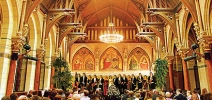Theater an der Wien overview
Vienna’s image is deeply influenced by the centuries of Habsburg imperial rule, during which the city thrived as cultural and political capital. The imperial bearing of Vienna seems to have held on long after the empire crumbled. It is a city marked by elegance and style, and it is a city in which the past is very much a part of the present.
However, what makes Vienna all the more fascinating are the points at which old and new intersect and something extraordinary results. These contrasts can be found at the Theater an der Wien. The building has housed all manner of music and theatre, from the premiere of Beethoven’s Fidelio to long runs of Cats and Phantom of the Opera.
The theatre was named for its location on the banks of the Wien River. The river now flows below the city’s surface at this point in its course, and it has made room for the Naschmarkt, a lively area to eat and shop. Opera goers today can find an assortment of local delicacies before heading into the theatre. This thoroughly modern ritual hardly suggests the long and substantial history within the relatively unassuming façade of the building.
Year of Construction: 1801
Architect: Franz Jäger
Theater an der Wien History
Theater an der Wien was founded in 1801 by Emanuel Schikaneder, who is perhaps better known for his libretto for Mozart’s The Magic Flute. Schikaneder’s entrepreneurial skills were apparently not as well honed as his talents as a librettist, and he was forced to sell the theatre only two years later. He remained as artistic director, and he brought in Ludwig van Beethoven as musical director and resident composer. Beethoven even lived in rooms at the theatre, performing regularly as both pianist and conductor.
The years that followed featured a colourful programme, including musical theatre productions with elaborate staging and effects. When Gioacchino Rossini’s operas arrived at Theatre an der Wien, they were received with genuine fury. In 1860, the theatre presented the first Viennese operetta, a genre that was to become as typical for the city as the waltz and apple strudel. Strauss’ “Die Fledermaus” premiered here in 1874, ushering in the golden age of the operetta in Vienna.
Like so many institutions that survived the war years, Theatre an der Wien served other, less noble functions from 1938 until 1945. Having closed as a theatre before Austria’s annexation by the Third Reich, the theatre was occasionally home to events of the Nazi-run “Strength through Joy” organisation, meant to provide entertainment promoting National Socialist ideology.
Theater an der Wien today
The reopening in 1945 with Beethoven’s Fidelio began the theatre’s return to its former glory. By 1951, the Theater an der Wien was among the most important opera houses in Europe. However, the value of the building was not universally appreciated, and after the State Opera moved out in 1955, there was talk of tearing the house down. The theatre was saved by a decision to house the Vienna Festival (Wiener Festwochen) there, and renovations brought the newest equipment to the stage.
The Theatre an der Wien left its classical roots behind between 1965 and 2005, moving its focus to Broadway musicals, as well as several productions written just for the house.
The theatre reopened in January, 2006 with a new identity as the New Opera House. Roland Geyer took over as director and transformed the theatre, with a truly innovative programme that successfully integrates the many aspects and periods of Vienna’s musical history up to the present day. Many of the “standard” works of the Viennese repertoire take on an absolutely modern character as performed in the theatre, which has assumed a central role in the city’s cultural life.
